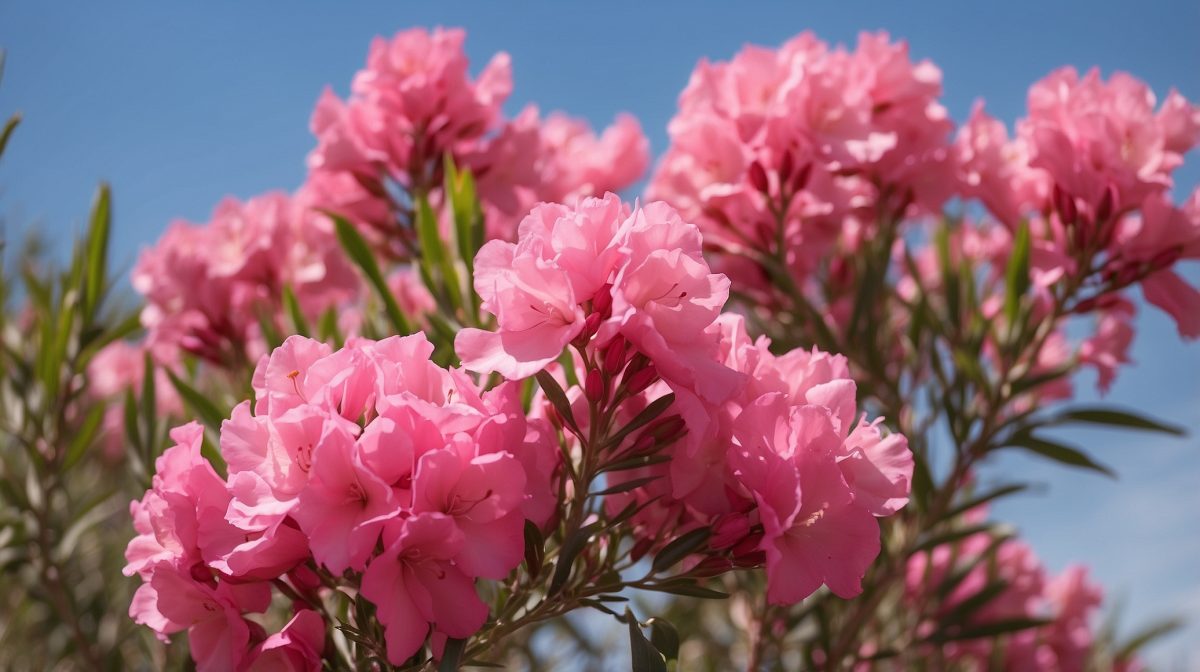Timing, my dear friends, is as important as the cut itself. Trimmin’ oleanders at just the right moment ensures they’ll grow healthy and put on a show of vibrant blooms that’ll be the envy of your neighbors. It’s all about understanding the rhythm of our local climate and the needs of these hardy plants.
Why Trim Oleanders
Now, y’all might be wonderin’ why you should bother trimmin’ your oleanders in the first place. Well, let me tell ya, it’s all about encouragin’ them to put out new growth and maintain a shape that’s as handsome as a new pair of boots. Plus, snippin’ away the dead or damaged branches keeps the plant healthy and lookin’ sharp.
But that ain’t all. By trimmin’ oleanders, you’re helpin’ to keep diseases at bay and improvin’ air circulation around the plant. This means your oleanders can breathe easy, just like we do after a long day’s work under the big Texas sky.
Best Time to Trim
Speakin’ of our Texas Hill Country climate, it sure does have its own set of rules. These rules dictate the growin’ seasons of our local flora, includin’ oleanders. Now, the best time to give these beauties a trimmin’ is typically after the last frost in late winter or early spring. That’s right before the new growth starts peekin’ out.
What you’re aimin’ for is to give your oleanders a good haircut before they wake up from their winter nap and get to growin’ again. This way, you’re settin’ them up for success, so they can strut their stuff when the warm sun comes a-callin’.
How to Trim Oleanders
If you’re fixin’ to trim your oleanders, you’ll need the right tools for the job. A pair of sharp, clean pruners is a good start. Now, when you’re ready to get down to business, you’ll want to follow a step-by-step guide to make sure you’re doin’ it right. Trimmin’ ain’t just about takin’ off the top; it’s about knowin’ which branches to cut and how much to take off.
My advice? Look for branches that are dead, damaged, or just don’t look like they’re doin’ the plant any favors. And remember, y’all, it’s about quality, not quantity. A little off the top might be all you need to keep those oleanders lookin’ as fine as cream gravy.
Common Mistakes to Avoid
Now, I’ve seen some folks get a bit too happy with the pruners and over-trim their oleanders. That’s a big no-no, y’all. Over-trimmin’ can stress out the plants and lead to less flowerin’, which is the exact opposite of what we want. It’s like takin’ too much off the brisket – it just ain’t right.
And one more thing – trimmin’ at the wrong time of year can be as bad as forgettin’ to take your hat off in church. If you trim too late or too early, you might leave your oleanders vulnerable to frost damage or the scorchin’ summer heat.
Aftercare
After you’ve given your oleanders a proper trimmin’, it’s time to show ’em some love. Water ’em well, give ’em a bit of fertilizer, and keep an eye out for any pests or diseases that might want to take advantage of the fresh cuts. It’s like tendin’ to a prized stallion after a race – they need that extra care to stay in prime condition.
And don’t forget to clean up those trimmin’s. Oleander cuttings can spread disease if left lyin’ around, plus they’re toxic to critters and humans alike. So, do the right thing and dispose of ’em properly, just like you would after a good day’s work on the ranch.
Conclusion
To wrap things up, remember that trimmin’ your oleanders at the right time is key to maintainin’ their beauty and health. It’s a bit like dancin’ – you gotta have good timin’ and know the steps. So, take pride in your Texas Hill Country garden and look forward to the burst of blooms that your oleanders will reward you with.
And remember, there’s nothin’ quite like the satisfaction of seein’ your hard work pay off when those oleanders show off their colors. So, keep your pruners sharp, your timing right, and your garden will be the talk of the town. Y’all take care now, ya hear?
FAQs
Can oleanders withstand a heavy prune, or should I be cautious with how much I trim?
Well, oleanders are pretty tough, but it’s best to be cautious. Heavy prunin’ should be done sparingly, as it can stress the plant.
Are there any particular pests or diseases I should look out for after trimming my oleanders?
Keep an eye out for common pests like aphids and diseases like oleander leaf scorch, especially after trimmin’.
How can I tell if my oleander is suffering from frost damage, and what should I do about it?
If you see blackened or mushy leaves after a frost, that’s a sign of damage. Prune the affected areas when the weather warms up.
Should I fertilize my oleander immediately after trimming, or is there a better time for that?
It’s best to fertilize after trimmin’, once the plant starts active growth, to give it a boost.
What’s the best way to dispose of oleander trimmings, considering their toxicity to animals and humans?
Dispose of trimmin’s in a yard waste bin or by takin’ them to a green waste facility, and keep them away from animals and children.


